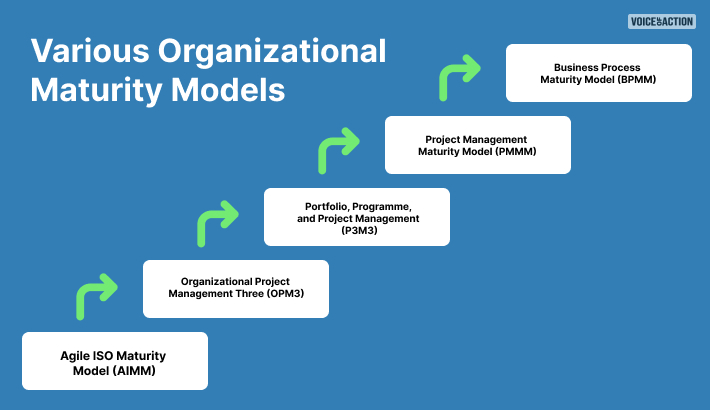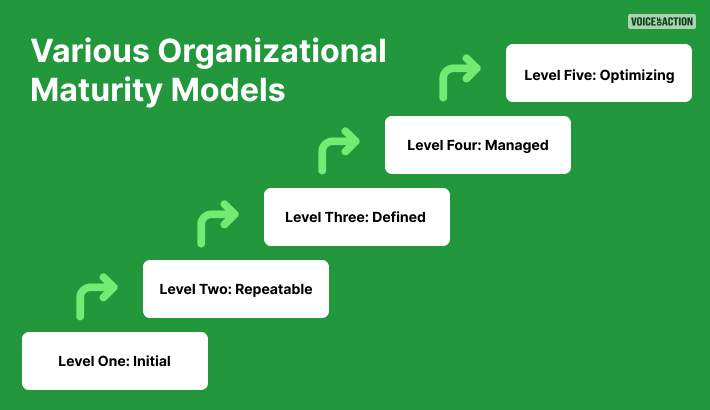Understanding Organizational Maturity: Exploring the Capability Maturity Model

A company’s operations are evaluated for quality according to its organizational maturity. A business with a high level of maturity can handle obstacles and exploit opportunities. The steady process of increasing organizational maturity promotes self-improvement. Because of this, software development companies need to comprehend the value of the Capability Maturity Model.
To learn more about this model and its five stages of development, read this post till the end.
What Is Organizational Maturity?
A company’s operations are evaluated for quality according to its organizational maturity. A business with a high level of maturity can handle obstacles and exploit opportunities. The steady process of increasing organizational maturity promotes self-development.
The importance of organizational maturity in the growth of a company’s operations cannot be overstated. You should endeavor to increase your maturity as you grow your firm, take on new projects, and form strategic alliances. Because they constantly adjust as they expand, mature entities are occasionally called mature organizations.
What Is A Maturity Model?
Like the Capability Maturity Model, a maturity model is a system or framework for evaluating an organization’s growth. These models often categorize maturation into various levels or phases. The key roles of HR in the organization can start working towards achieving a greater organizational maturity level once they know their existing organizational maturity.
You may be tempted to place the blame for failed initiatives or procedures due to subpar technological and human errors. However, if a company develops itself to manage the scope or complexity of all its endeavors, these projects and processes will succeed.
Companies must recognize their maturity level and tailor initiatives to their existing capabilities since sustained failure can leave workers feeling dejected and defeated. This makes it easier to invest in business future.
The majority of organizational maturity models contain five levels or stages, along with a checklist of each stage’s distinguishing traits. These traits may indicate qualitative facets of an organization, including corporate culture and governance arrangements. They might also be used to describe routine, measurable actions and procedures.
Any size or style of company, from big financial institutions to tiny NGOs, uses maturity models like Capability Maturity Model. These frameworks can also be used to organize other organizational divisions. Whatever the business, executives may utilize maturity models to pinpoint issues and assess progress.
Various Organizational Maturity Models

There are several maturity models (apart from the Capability Maturity Model), each assessing a unique component of adulthood. You must remember that different models support different small town business ideas.
Based on survey results and statistical research, experts created these models and validated their underlying assumptions. Learning them all guides you toward achieving all the successful entrepreneur qualities. The different maturity models are:
1. Agile ISO Maturity Model (AIMM)
This model, created with Agile methodologies in mind, attempts to satisfy the requirements established by the ISO (International Organization for Standardization).
2. Organizational Project Management Three (OPM3)
You may evaluate the organization’s management of the project’s maturity in managing programs and portfolios using this approach, created by PMI (Project Management Institute).
3. Portfolio, Programme, and Project Management (P3M3)
In this approach, the UK-based Axelos maintains and assesses each organizational maturity prospective or feature on a scale of one to five. Your management of the portfolio, management of programs, and project management maturity may be evaluated using the P3M3 model.
4. Project Management Maturity Model (PMMM)
This well-known corporate project administration maturity evaluation, developed by PM Solutions, employs a five-level methodology to determine the level of maturity of a company’s project administration systems and procedures.
5. Business Process Maturity Model (BPMM)
This model offers recommendations for enhancing process maturity and standardizing organization-wide procedures, and it is based on the Process Maturity Framework developed at IBM in the 1980s.
What Is Capability Maturity Model?
The Capability Maturity Model was initially created as a tool for evaluating the procedures used by government contractors to carry out a software project under contract.
The model is built on the framework for measuring process maturity, which Watts Humphrey initially introduced in his 1989 book “Managing the Software Process” and later in IEEE Software. Later, the same writers released it as a book in 1995 after publishing it as a report in 1993.
Although the model originates from software creation, it is widely utilized in government institutions, businesses, and industries around the globe to help with general business processes.
The Five Levels Of The Capability Maturity Model

To understand what is CMM (Capability Maturity Model), you must learn the five CMM levels are and how to define CMM model:
Level One: Initial
The development of software is described as being uneven and, at times, even chaotic. During a crisis, established procedures and best practices are abandoned. The labor, talent, and skills significantly contribute to the organization’s success.
Eventually, the leaders leave their current organizations and others, bringing them a wealth of information or lessons learned.
Level Two: Repeatable
For tracking cost, time, and functionality, this level of programming organization uses a simple, standardized project management procedure. The procedure is used on projects related to replicating past results. An essential quality of a level-two company is program management.
Level Three: Defined
All projects within the company use an approved, customized variation of the company’s standard CMM software for designing, testing, and sustaining the application. The software procedure for management and engineering tasks has been recorded, standardized, and incorporated into an established software procedure for the entire organization.
Level Four: Managed
By using various measures, management can efficiently manage the software development process. At this stage, an organization establishes a measurable quality objective for the software development and maintenance processes.
At this stage of development, processes’ performance is governed by statistics and other quantitative techniques. Therefore, the Capability Maturity Model makes everything statistically predictable.
Level Five: Optimizing
This level’s focus on continuously enhancing process performance via incremental and novel technology advancements is an essential characteristic. At this stage, process modifications are made to improve the process’s functionality while maintaining the statistical likelihood that the set quantitative process-improvement goals will be met.
Conclusion
The Capability Maturity Model (CMM) of the Software Engineering Institute (SEI) outlines a software development company’s ascending hierarchy of stages. The application development process improves with the level. As a result, getting to each level is a costly and time-consuming procedure.
More Resources:


























